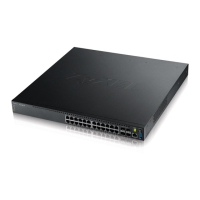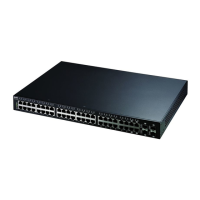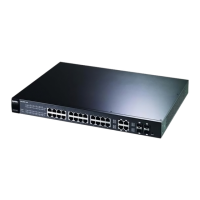Chapter 28 Layer 2 Protocol Tunneling
GS3700/XGS3700 Series User’s Guide
310
The following table describes the labels in this screen.
Table 145 Advanced Application > Layer 2 Protocol Tunneling
LABEL DESCRIPTION
Active Select this to enable layer-2 protocol tunneling on the Switch.
Destination
MAC Address
Specify an MAC address with which the Switch uses to encapsulate the layer-2 protocol
packets by replacing the destination MAC address in the packets.
Note: The MAC address can be either a unicast MAC address or multicast MAC address. If
you use a unicast MAC address, make sure the MAC address does not exist in the
address table of a switch on the service provider’s network.
Note: All the edge switches in the service provider’s network should be set to use the same
MAC address for encapsulation.
Slot (Stacking
mode)
This field appears only in stacking mode. Click the drop-down list to choose the slot number
of the Switch in a stack.
Port
(Standalone or
stacking mode)
This field displays the port number. In stacking mode, the first box field is the slot ID and
the second field is the port number.
* Use this row to make the setting the same for all ports. Use this row first and then make
adjustments on a port-by-port basis.
Note: Changes in this row are copied to all the ports as soon as you make them.
CDP Select this option to have the Switch tunnel CDP (Cisco Discovery Protocol) packets so that
other Cisco devices can be discovered through the service provider’s network.
STP Select this option to have the Switch tunnel STP (Spanning Tree Protocol) packets so that
STP can run properly across the service provider’s network and spanning trees can be set up
based on bridge information from all (local and remote) networks.
VTP Select this option to have the Switch tunnel VTP (VLAN Trunking Protocol) packets so that all
customer switches can use consistent VLAN configuration through the service provider’s
network.
Point to Point The Switch supports PAgP (Port Aggregation Protocol), LACP (Link Aggregation Control
Protocol) and UDLD (UniDirectional Link Detection) tunneling for a point-to-point topology.
Both PAgP and UDLD are Cisco’s proprietary data link layer protocols. PAgP is similar to
LACP and used to set up a logical aggregation of Ethernet ports automatically. UDLD is to
determine the link’s physical status and detect a unidirectional link.
PAGP Select this option to have the Switch send PAgP packets to a peer to automatically negotiate
and build a logical port aggregation.
LACP Select this option to have the Switch send LACP packets to a peer to dynamically creates
and manages trunk groups.
UDLD Select this option to have the Switch send UDLD packets to a peer’s port it connected to
monitor the physical status of a link.
Mode Select Access to have the Switch encapsulate the incoming layer-2 protocol packets and
forward them to the tunnel port(s). Select Access for ingress ports at the edge of the
service provider's network.
Note: You can enable L2PT services for STP, LACP, VTP, CDP, UDLD, and PAGP on the
access port(s) only.
Select Tunnel for egress ports at the edge of the service provider's network. The Switch
decapsulates the encapsulated layer-2 protocol packets received on a tunnel port by
changing the destination MAC address to the original one, and then forward them to an
access port. If the service(s) is not enabled on an access port, the protocol packets are
dropped.

